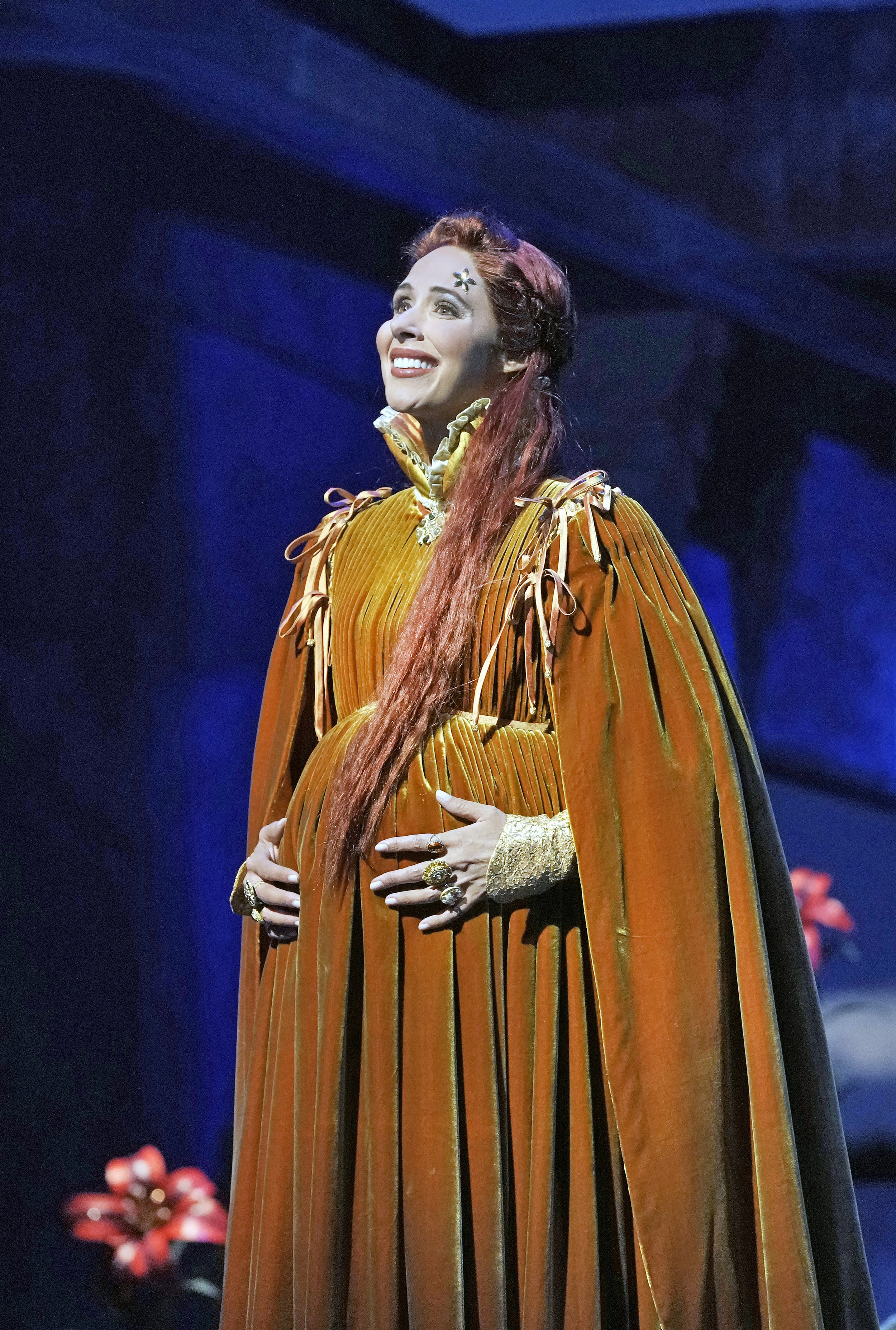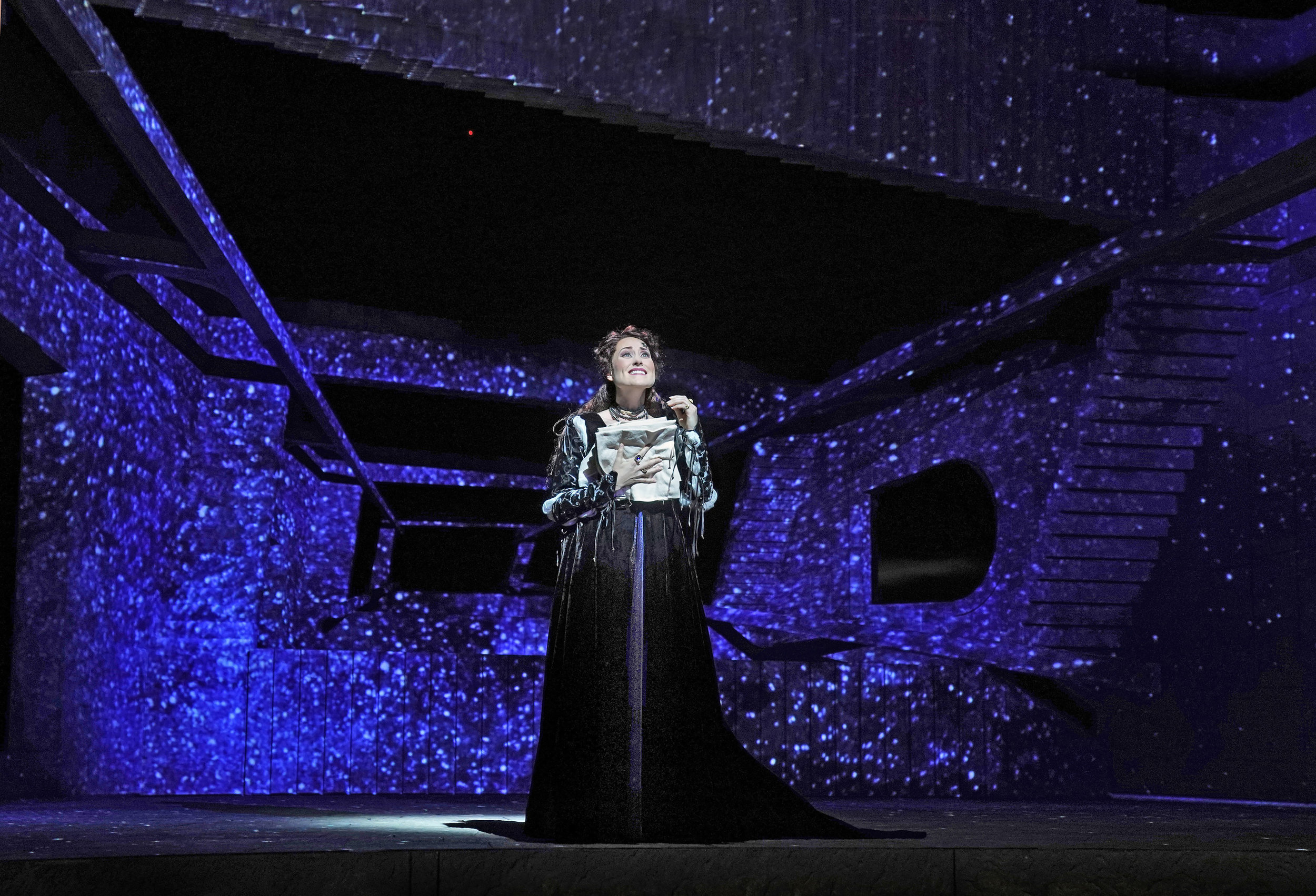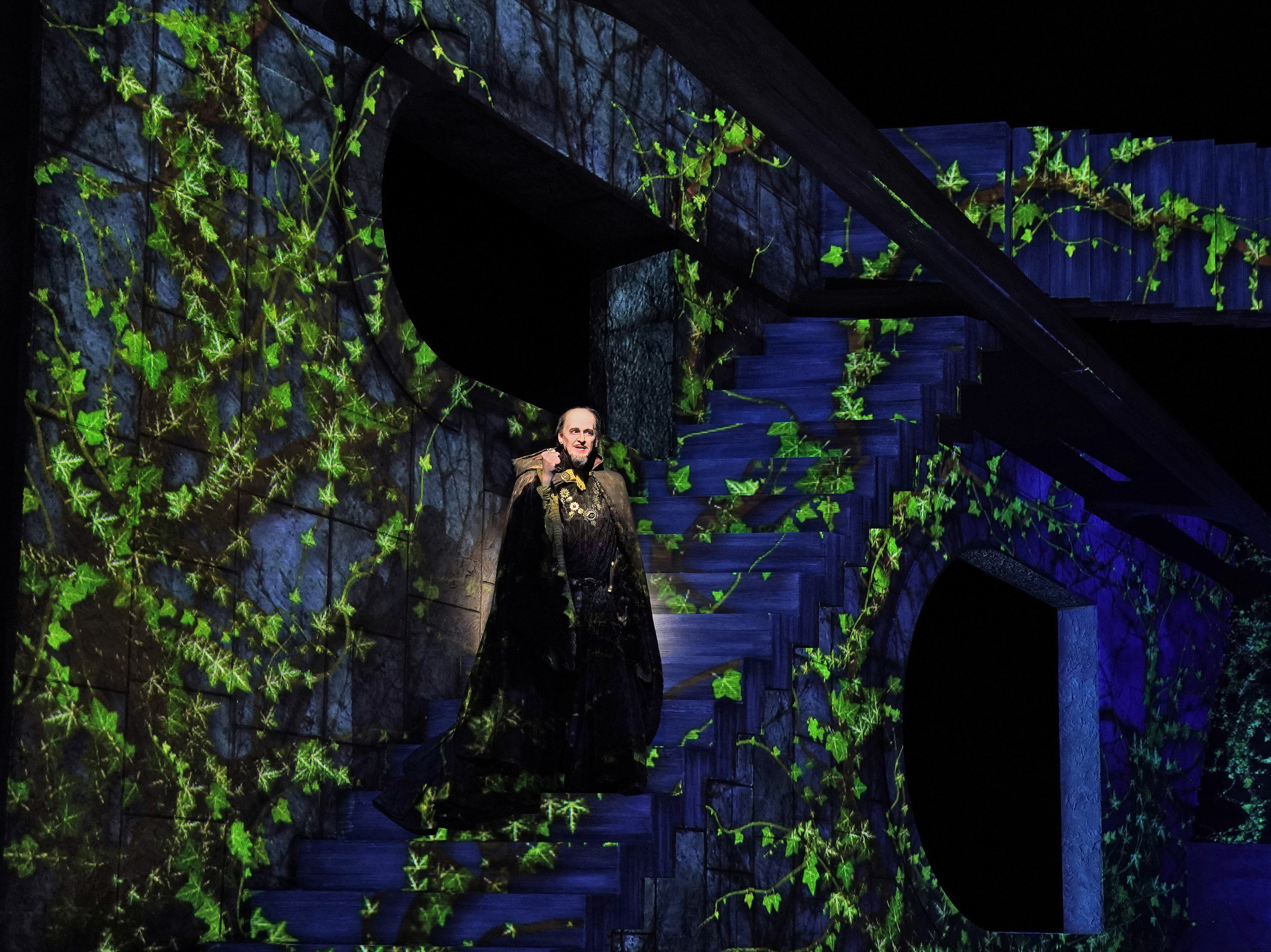(This is Part II of a three-part series based on an August 2019 trip to attend two operas at the Santa Fe Opera. Part I on The Fan Experience is posted and part III on Cosi fan tutte will follow.)
King Hjarne (David Leigh) talks with his young son Corbin as a worried Queen Gertrude (Tamara Mumford) and other sons look on. Photo by Ken Howard; courtesy of Santa Fe Opera.
The Thirteenth Child is a new opera by Danish composer Poul Ruders and American librettists Becky and David Starobin, based on the Brothers Grimm fairy tale, “The Twelve Brothers”. The Santa Fe Opera production which was performed in July/August was a world premiere and a co-production with Denmark’s Odense Symphony Orchestra. In the Grimm’s tale, a king plans to kill his twelve sons if the next child born is a girl, the thirteenth child. The boys flee to hide in the woods and plot their revenge on the girl. When she is grown, their sister learns about them and seeks them out; they successfully reconcile and live together. The sister cuts down twelve lilies for a celebration only to find out this action turned her brothers into twelve ravens. Her quest for redemption involves staying silent and without expression for seven years. Near the end of this term, her life is threatened as she draws near completing her quest; just in time, the seven years is up, causing her brothers to turn back into human form and come to her rescue. There are a few versions of this short, but little-known tale, easily accessed via Google. Ms. Starobin changed the story somewhat to fit the needs of presenting it as an opera, then she and Mr. Starobin developed the libretto from their modified version: a motive is added for the King’s actions - he is mentally ill and fears his sons will take his throne; the queen gets a bigger role; and, a power-hungry, evil prince is added as the villain, as well as a good prince for romance. The good versus evil theme is more focused. There are several turns in the story that seem unexplained on a conscious level, but fairy tales move in the wonderland of the collective unconscious; the stories spin on the interactions of the archetypes and our visceral reaction to them. I was scared and angry at the King, sympathetic with the mother, sorry for the boys, hissed at the villain, cheered for the daughter, and was sad for innocent Ben, the youngest boy. Overall, the story worked. The problem is that it worked like a fairytale in a Disney movie, a likeable diversion, but lacking the transformative impact that one expects from opera. It doesn’t confront modern issues; neither is it thought-provoking. In fairness, I should report that my wife liked the story significantly more than I did; her argument is that it was a treat to see a fairy tale in opera form, and it doesn’t have to be more than that. At only an hour and twenty minutes, The Thirteenth Child, is fine entertainment, but for me, the high art comes from the music and the quality of the production, which in SFO’s hands was very well done.
l to r: Tamara Mumford as pregnant Queen Gertrude; Jessica E. Jones as her daughter, Princess Lyra, the thirteenth child. Photos by Ken Howard; courtesy of Santa Fe Opera.
The Thirteenth Child is the fifth opera by Mr. Ruders, a prolific and highly regarded composer of classical music. He made a splash recently with a Boston Lyric Opera production of his opera, The Handmaid’s Tale (2000), based on the book by Margaret Atwood, now known by many of us from the Hulu mini-series. Modern opera is scary for the average opera fan. The question that always looms is will I like the music? Even today, after I have attended quite a few modern works, I wonder how much dissonance and atonal music I will have to endure when I approach a new one. But having said that, I have also come to realize that atonal and dissonant music and sounds can be effective in creating mood and adding to the tension in certain situations. My wife had read that Mr. Ruders described his music for The Thirteenth Child as “ear candy with chili peppers.” I am happy to report that Mr. Ruders’ score is a mixture of atonal and tonal music; these elements are used effectively together and unlike some modern works, his score has several beautiful, lyrical arias. Mr. Ruders has mastery of all these elements. The lyrical elements are used judiciously rather than to simply add beauty overall. The music is created specifically for each scene using combinations of instruments and sections of the orchestra in cleverly effective ways, but central themes (that I was able to detect on one hearing) were lacking that might weave the story together into a more unified musical composition; also lacking was a standout melody that might call to mind the opera when you hear it (one reviewer did claim to have spotted a leitmotif for Queen Gertrude in several scenes; so, maybe there was more than I realized). I thought the music was enjoyable and interesting throughout and did its job in adding to the emotion and story line. I thought that the orchestra and Conductor Paul Daniel did a marvelous job, and the children’s chorus led by Chorus Master Suzanne Sheston was used effectively. There is a recording out of the opera with a largely different cast made before the opera was performed on stage, and a future recording is in the works. My bottom line is that I think you should look forward to this music and not worry about its modernity if you get a chance to see it; the music is good, and Boston Lyric Opera, San Francisco Opera, and the Royal Danish Opera currently have scheduled productions. I have listened to the recording since returning home, and I like the music more than I realized at the time, when I was taking in all the other aspects of the opera as well. Maybe being in the southwest I was first experiencing the chili peppers and now the sweetness is coming through. I also admit that after attending The Thirteenth Child, I am even more inclined to see composer Ruders’ The Handmaid’s Tale, though it is a much darker opera.
Bradley Garvin as Drokan in a spectacular set. Photo by Ken Howard; courtesy of Santa Fe Opera.
I thought the cast of singers was uniformly excellent and certainly the vocals were a highlight of the opera. I especially liked mezzo-soprano Tamara Mumford as Queen Gertrude, the guiding force for good in this version of the story. She sang beautifully with a voice perfectly suited for the role. In an aria in Act II when Gertrude returns as an apparition, she sings an aria with a ghostly echo. I was curious how this was managed and received the following response from SFO, “The ghostly echo effect was achieved with a wireless microphone. It was the only microphone used on stage, and only for that scene. The effect was written in by the composer and was also very important to the librettists. They all worked closely with our A/V Technician, the head of our Music Staff, and the conductor to achieve the desired effect, which was then mixed every performance night live from the house.” It is impressive that the singers can be heard all the way to the back row in an open-air opera house of this size without amplification.
Princess Lyra (Jessica E. Jones) is visited by the ghost of Queen Gertrude (Tamara Mumford). Photo by Ken Howard; courtesy of Santa Fe Opera.
Newcomer soprano Jessica E. Jones also sang beautifully with a lovely voice and gave an effective portrayal of gentle goodness as Princess Lyra, charged by her mom with finding her brothers. David Leigh, who played Hjarne, King of Frohagord, is a young bass who already has appeared in major opera houses and can sing low enough to make your table rattle. He threw in falsetto to add to the sense that the King was unbalanced. He also appeared in a second role as the grown Corbin, eldest of the brothers. Base-baritone, Bradley Garvin who sang the role of Drokan, Regent of the Kingdom of Hauven, projected a suitably detestable and menacing villian. Tenor Johsua Dennis served capably as Prince Frederic, Lyra’s love interest, though in a role that was not well-developed in the opera. Young tenor Bille Bruly gave a heart-rendering performance as Ben, the youngest sibling; I am intrigued enough to want to see a bit more of Mr. Bruly.
Here’s the thing – the story is good and the music is good, but two things are required to make this a successful opera, I think. Excellent performers, of course, but one more aspect is critical for The Thirteenth Child – staging. Something has to keep us engaged while the archetypes are moving around in our heads. In general, Director Darko Tresnjak and the SFO creative team did this well. Even so, a little more magic would have aided keeping the audience enthralled and more effectively bringing out some of the ties between the characters. In the scene where Gerturde sent Lyra with a key to bring her the contents of a cabinet drawer, Lyra walks offstage and returns with its contents. In that moment, I was so hoping for a holographic chest to appear by the wall when the key came near. Also, the scene where Lyra is replaced by the villain in the fire was a little awkward; he was subdued so easily that there was a small ripple of laughter at a moment when people should have been holding their breath. In the Grimm tale, the villain is thrown into a vat of oil filled with poisonous snakes, a powerful image. On stage, the fire needs to appear more threatening and its victims more resistant than we were presented. The part human, part raven Ben at the end worked to evoke a bittersweet edge to the ending.
Princess Lyra (Jessica E. Jones) comforts Ben, who was wounded before returning completely to human form. Photo by Ken Howard; courtesy of Santa Fe Opera.
I thought the set used was spectacular and worked very well (scenic design by Alexander Dodge), and the costumes were wonderful (costume design by Rita Ryack). The set was primarily an interior castle wall that wrapped around the stage with openings and stairs on either side and open in the rear, coupled with just a few pieces of furniture from time to time; the sides and back were covered in a dark blue glaze of light that glittered (lighting design by York Kennedy), an overall very dramatic effect. The walls were used effectively as a screen for lighting and images (projection design by Aaron Rhyne), such as large serpents moving around on the walls, great for the mood changes and instilling a feeling of being in a wondrous place (as did I might add seeing the real sunset through the back of the stage and hearing the rain that fell sporadically during the performance). Fairy tales need their magic.
My experience was no doubt enhanced by the special excitement of attending a premiere and the also special excitement of attending one’s first opera at the Santa Fe Opera; I am curious to see how the opera does in future productions. Still, I say go see The Thirteenth Child when it comes to your area (my wife enthusiastically concurs). The operatic impact is moderate, but the entertainment value is quite good. And dang if that music doesn’t keep growing on me.
The Fan Experience: I covered this aspect in Part I of this series; take a look if you don’t know what a wonderful ride the Santa Fe Opera is. My single caution is that if you are buying tickets that are way on the side, like for just about any opera house, inquire from the ticket office whether you will lose sight of a small portion of the stage, not a major consideration and those side seats are a bargain, but unpleasant if you are surprised. I found driving to, parking, and exiting SFO to be relatively straightforward. The SFO website is comprehensive in providing all the logistics info you need, including the fact that the nights in the desert in an open-air theater can get chilly. The pre-opera talks are exceptional and are given both one and two hours before the performance. Food is available, including a special purchase, elegant buffet dinner with its own pre-opera talk, but also consider tailgating, an SFO tradition.
SFO’s new season, July and August 2020, has already been announced. If you want to enrich your arts and cultural experience even more, consider visiting while the 99th annual Santa Fe Indian Market is occurring, August 15-16, 2020.






